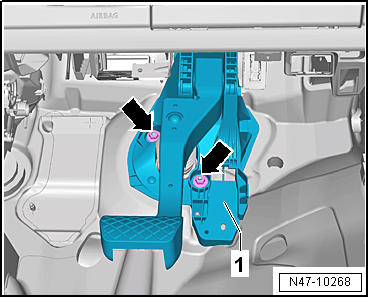Volkswagen Golf Service & Repair Manual: Removing and installing brake servo, right-hand drive vehicle
| Special tools and workshop equipment
required |
|
|
|
| Torque wrench -V.A.G 1331- |
|
|
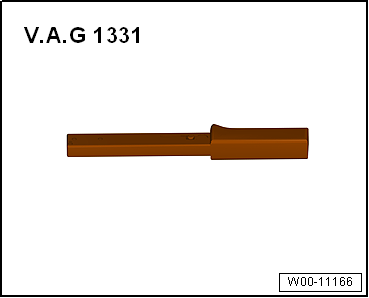
|
| Torque wrench -V.A.G 1410- |
| Tool inserts (11 mm) -V.A.G 1331/2- |
|
|
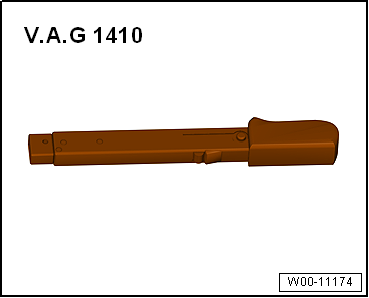
|
| Brake filling and bleeding equipment -VAS 5234- |
|
|
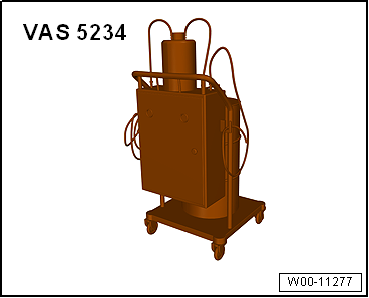
|
| Sealing plug repair kit -1H0 698 311 A- |
| Hot air blower, e.g. hot air blower -VAS 1978/14A- |
|
|
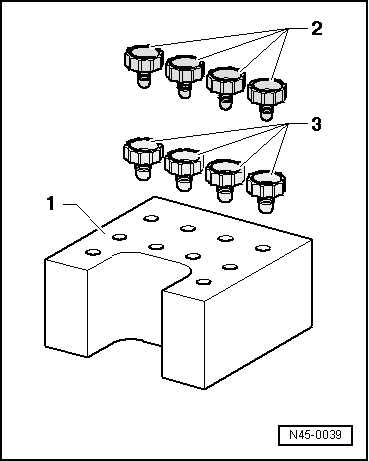
|
| The brake servo with brake master cylinder is located on the
right-hand side of the engine compartment. |
| 1 - |
Brake servo and brake master cylinder |
| 2 - |
Brake system pressure accumulator -VX70- |
| 3 - |
ABS control unit -J104- with ABS hydraulic unit -N55- |
| Do not bend the brake lines in the area of the hydraulic
unit! |
| – |
Observe safety precautions when working on the high-voltage
system
→ Chapter. |
| – |
Observe the risk classification of the high-voltage system
→ Electric drive; Rep. gr.00. |
|
|
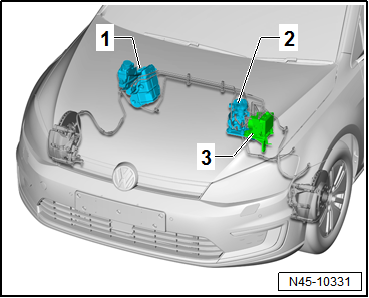
|
| Danger to life due to high voltage |
| The high-voltage system is under high voltage. If high-voltage
components are damaged, there is a risk of severe or fatal injury due to
electric shock. |
| – |
Carry out visual inspection of high-voltage components and cables. |
| – |
Never use cutting or forming tools, or any others with sharp edges. |
| – |
Never use heat sources such as welding, soldering, thermal bonding
or hot air. |
| – |
Disconnect battery
→ Electrical system; Rep. gr.27. |
| – |
Remove brake master cylinder
→ Chapter. |
| – |
Remove catalytic converter
→ Rep. gr.26. |
| – |
Unclip air conditioning line in the area of the brake servo
→ Heating, air conditioning; Rep. gr.87. |
| – |
Remove footwell cover on driver side
→ General body repairs, interior; Rep. gr.68. |
| – |
Remove storage compartment on driver side
→ General body repairs, interior; Rep. gr.68. |
| – |
Remove footwell vent -1- on
driver side
→ Heating, air conditioning system; Rep. gr.87. |
|
|
|
| – |
Mark brake lines -A- and
-B- on brake master cylinder
-1-. |
| – |
Unscrew brake lines -A- and
-B- from brake master cylinder. |
| – |
Immediately seal brake lines and open connections with
sealing plugs from repair kit -1H0 698 311 A- or suitable plugs
from engine bung set -VAS 6122-. |
| – |
Carefully pull brake servo off plenum chamber bulkhead. |
| – |
Lay brake servo to side. |
|
|
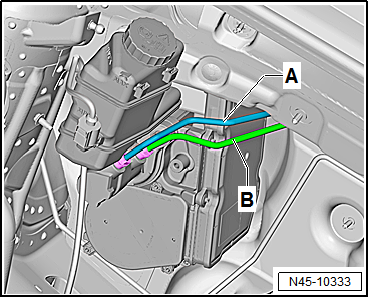
|
| – |
Release connector -2- and pull
it off brake servo -1-. |
| Ensure no brake fluid gets onto contacts. |
| Never allow brake fluid to come into contact with fluids
that contain mineral oils (e.g. oil, petrol, cleaning agents).
Mineral oils damage the plugs and seals in the brake system. |
| Brake fluid is poisonous and must never be sucked out by
mouth through a hose. Because of its caustic properties, it must
also not come into contact with paintwork. |
| Do not reuse drawn-off brake fluid. |
| Always observe the relevant environmental regulations for
disposal. |
|
|
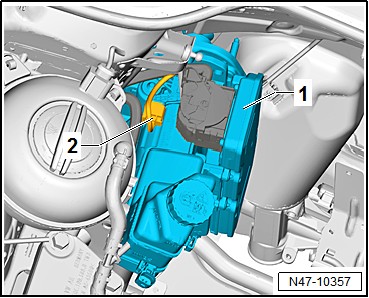
|
| – |
Pull locking slide (red) -1-
towards front. |
| – |
Press release tab -3- on
connector -4-. |
| – |
Release latch -2- and pull
connector -4- off brake servo
-5-. |
|
|
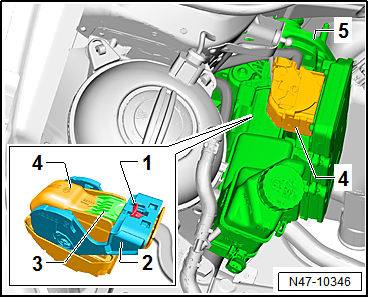
|
| – |
Remove adhesive residue -arrows-
from brake servo -2- and plenum
chamber bulkhead -1-. |
| – |
To do so, apply gentle heat from hot air blower to the
adhesive residue and pull it off. |
| – |
Thoroughly clean surfaces. |
| Install in reverse order. Note the following points: |
| – |
Renew seal between brake servo and plenum chamber bulkhead
→ Item. |
| – |
Carefully insert brake servo and tighten nuts hand-tight. |
| – |
Connect brake pedal to brake servo
→ Chapter. |
| – |
Bleed brake system
→ Chapter. |
| – |
Subsequently bleeding the brake system
→ Chapter. |
| – |
Code brake servo control unit -J539-
→ Vehicle diagnostic tester. |
| – |
Perform basic setting for electromechanical brake servo
→ Vehicle
diagnostic tester. |
| → Chapter „Assembly overview – Brake system pressure accumulator
-VX70-, RHD vehicles“ |
| → Electrical system; Rep. gr.27. |
| → Electrical system; Rep. gr.27 |
| → General body repairs, interior; Rep. gr.68 |
| → Heating, air conditioning system; Rep. gr.87. |
|
|
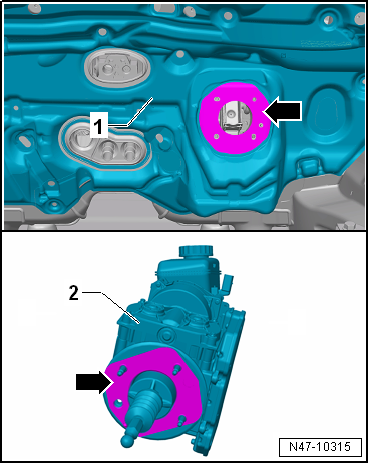
|
Special tools and workshop equipment
required
Torque wrench -V.A.G 1331-
...
Repairing brake lines
The flanging tool for brake lines -VAS 6056- can be used to
flange brake lines with an outer pipe diameter of 5 mm without ...
Other materials:
Removing and installing centre underbody covers
Note
The removal and installation procedures may have to be modified
slightly depending on engine fitted.
Removing
Unclip spreader river -2- and remove
centre underbody panels.
Installing
Installation is carried out in reverse ...
Renewal of aerial wiring
A new approach to repair work on aerial wires has been
developed
→ Chapter.
Now connecting wires in different lengths and various
adapter cables are available as replacement parts instead of a
complete aerial wire.
...
Tyre monitoring indicator lamp
First read and observe the introductory information
and safety warnings
Lit up
Possible cause
Solution
The tyre pressure of one tyre or several tyres has decreased considerably
in comparison to the tyre pressure set by the ...
© 2016-2025 Copyright www.vwgolf.org

 Note
Note Note
Note Removing and installing brake servo, LHD vehicles
Removing and installing brake servo, LHD vehicles Brake lines
Brake lines





